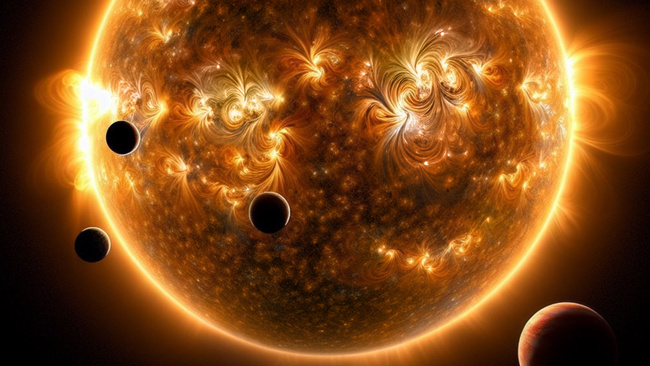
Astronomers have discovered a unique system of planets consisting of six young exoplanets, and possibly a seventh, orbiting the young star TOI-1136. This discovery not only helps to deepen our understanding of the process of formation and development of planets around young stars, but also may be analogous to our solar system in the early stages of its existence, about 4 billion years ago.
TOI-1136 is a nearby dwarf star in the Milky Way, located about 270 light-years from Earth. Scientists are fascinated by this planetary system because of its rarity – few systems have such a large number of planets. It is roughly comparable to our solar system in size, and has diversity and similarities that allow us to make discoveries about solar systems of similar configurations.
The original study of this planetary system began using NASA’s TESS space telescope in 2019. But for more detailed information, astronomers have made long-term observations from various Earth-based telescopes to determine the mass of the planets, the shape of their orbits, and the characteristics of their atmospheres.
The planets in the TOI-1136 system from TOI-1136b to TOI-1136g are classified as sub-Neptunes. The smallest of the six planets already confirmed is twice the size of the Earth, while the other planets discovered in this system are four times the size of the Earth, similar to the ice giants Uranus and Neptune.
All the planets in the TOI-1136 system orbit their star so closely that a complete revolution takes less than 88 Earth days. The rotation period of the planet Mercury, the closest to the Sun, is also 88 days. Studying these planets allows us to imagine that they are closer to their star than Mercury is to the Sun.
The exoplanets in the TOI-1136 system are a unique class, different from those in our solar system. However, from the study of other planetary systems, more and more scientists are inclined to believe that this class of planets may be the most widespread in the galaxy, opening up new horizons in understanding the cosmos.
However, the most interesting thing about TOI-1136 is the age of the planets and their stars. Just 700 million years old, they are relatively young by cosmic standards. Compared to the solar system, which is about 4.5 billion years old, this system seems very young. This creates an unrivaled opportunity to study the planets immediately after their formation and allows us to delve deeper into the process of emergence and development of planetary systems, including the preconditions for the emergence of our solar system.
In addition, young stars like TOI-1136 require special attention due to their superactivity. Due to the strong magnetism and intense sunspots and flares characteristic of young stars, these observations are of particular interest to the astronomical community.
The radiation emitted by young stars has a huge impact on the formation and evolution of the planets orbiting them. This activity of young stars creates special conditions for the planets, affecting their atmospheric characteristics and changes over time.
“Young stars are constantly showing their ‘excitability’, they are very active, like babies. This creates difficulties in making accurate measurements. However, such measurements not only allow us to compare changes on the planets, but also to study how the atmospheres of these planets have evolved at different distances from their star, which is one of the most important aspects of such studies,” said Stephen Kane, team leader and professor of planetary astrophysics at the University of California.
One of the special aspects of the TOI-1136 system is that all the planets in it are approximately the same age and are located very close to each other. This makes this system exceptional for research.
Thanks to the Automated Planet Finder telescope at Lick Observatory in California and the high-resolution Eschelle Spectrometer at Keck Observatory on Mauna Kea in Hawaii, the researchers were able to detect the wobbles of the planets. The analysis of these fluctuations using computer models and data on planetary transits made it possible to determine the masses of the planets with high accuracy.
“There was a lot of trial and error, but we are pleased with the results we have obtained, creating one of the most complex models of exoplanetary systems to date,” said lead author of the study and a doctoral candidate at the University of California, Irvine.
In our solar system, life emerged about 600 million years after its formation in a period called the Archean. Astronomers are looking at the exoplanets of the TOI-1136 system in the early stages of their development. However, due to their proximity to the parent star, the chances that these planets can support life seem unlikely. The star’s intense radiation likely destroys the atmosphere and evaporates liquid water, which is a key factor for the development of life as we know it.
“I am increasingly coming to the conclusion that our system is unique in the Universe. The discovery of systems other than ours allows us to better understand how our solar system fits into the overall context of the formation of planetary systems around other stars,” said Kane.
Next, the team intends to continue researching the TOI-1136 system, hoping to confirm the presence of a seventh planet and determine the composition of the planets’ atmospheres. This is what could be achieved with the James Webb Space Telescope.

